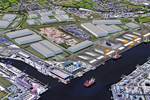GE Renewable Energy receives planning approval for wind blade manufacturing plant
Plant construction is set to begin later this year upon the finalization of all contractual documents and will be completed in 2026, making the Dogger Bank the world’s largest offshore wind farm.
(Paris, France) has received the official planning approval for its Teesside offshore wind blade manufacturing plant from local planning authorities. This is the first major milestone in the lead up to the construction of this facility on the South Bank of Teesworks.
According to the company, the plant construction should begin later in 2021 upon the finalization of all contractual documents. As previously announced, (Kolding, Denmark) will operate the facility, which will be dedicated to the production of its 107-meter-long offshore wind turbine blades, a key component of GE’s Haliade-X.
Olivier Fontan, president & CEO of LM Wind Power, says, “We are delighted to have received this important approval from the local planning authorities and are thankful for the collaboration between all parties involved. There is still a lot of work in front of us, but this an important milestone for the construction and future opening of the facility. We are proud of the contribution we will be making in rejuvenating this industrial cluster and helping it play a key role in future of renewable energy.”
Recruitment for the plant is scheduled to begin in mid-2022, with an estimated 750 direct positions to be filled. An additional 1,500 indirect jobs are to be created to support the entire supply chain around the factory.
When production starts, the Dogger Bank offshore wind farm is projected to benefit directly from the blades produced at this new plant. The three phases of the Dogger Bank Wind Farm, powered by GE’s Haliade-X offshore wind turbine, will reportedly have a combined installed generation capacity of 3.6 gigawatts (GW) — enough to power six million U.K. homes. According to GE, upon completion in 2026, Dogger Bank will be the world’s largest offshore wind farm.
Related Content
-
Polar Technology develops innovative solutions for hydrogen storage
Conformable “Hydrogen in a Box” prototype for compressed gas storage has been tested to 350 and 700 bar, liquid hydrogen storage is being evaluated.
-
Ceramic matrix composites: Faster, cheaper, higher temperature
New players proliferate, increasing CMC materials and manufacturing capacity, novel processes and automation to meet demand for higher part volumes and performance.
-
RTM, dry braided fabric enable faster, cost-effective manufacture for hydrokinetic turbine components
Switching from prepreg to RTM led to significant time and cost savings for the manufacture of fiberglass struts and complex carbon fiber composite foils that power ORPC’s RivGen systems.






